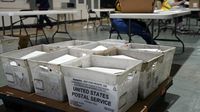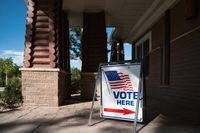President Donald Trump’s latest move to ban mail-in voting has sent shockwaves through America’s electoral landscape, igniting fierce debate among voters, election officials, and legal experts across the country. On August 21, 2025, Trump announced his intention to sign an executive order eliminating mail-in ballots ahead of the 2026 midterm elections, citing persistent—yet unsubstantiated—claims of widespread voter fraud. The announcement, made both on social media and during a press conference alongside Ukrainian President Volodymyr Zelensky, left many wondering: Can a president really upend the way Americans vote with the stroke of a pen?
Trump’s proposal wasn’t born in a vacuum. According to The Atlantic, he credited Russian President Vladimir Putin with inspiring the idea, claiming Putin told him, “You can’t have an honest election with mail-in voting.” Trump then declared, “We’re going to end mail-in voting. It’s a fraud.” Days after his Truth Social post and Oval Office remarks, the promised executive order had yet to materialize, but the political and legal aftershocks were already rippling across the nation.
For millions of Americans, mail-in voting isn’t just a convenience—it’s a necessity. Data from the 2024 general election in Ohio, reported by News5Cleveland.com, showed that 1.1 million Ohioans voted by mail, with voters over 65 leading the way by returning about 520,000 ballots. The next highest group, aged 55 to 64, returned about 205,000 ballots. Surprisingly, more registered Republicans than Democrats in Ohio used mail-in ballots in 2024, a fact that challenges Trump’s assertion that mail voting primarily benefits Democrats. Unaffiliated voters topped the list, followed by Republicans and then Democrats. As Jen Miller of the League of Women Voters of Ohio put it, “I like voting because I believe that our democracy works best when we’re all participating.” She emphasized that mail-in voting is “safe, secure and effective for each party.”
The significance of mail-in voting extends beyond party lines. “It’s particularly important for older adults, military members, rural Ohioans, voters with disabilities, and students,” Miller added. In Florida, the story is similar. According to local Tampa Bay news outlets, more than three million Floridians cast ballots by mail in 2024, including over one million Republican voters. Pasco County Supervisor of Elections Brian Corley shared that his office has already received calls from worried voters, including people with disabilities concerned about how they would vote if mail-in options disappeared. “I explained to that person that it’s an executive order, it’s not legislative, it’s unconstitutional,” Corley said, expressing strong opposition to the proposed change. Florida Governor Ron DeSantis even called Florida’s mail-in voting system the “gold standard,” distancing his state from the controversy and suggesting Trump’s criticism targeted other states that send unsolicited ballots.
Despite Trump’s claims—“Mail-in ballots are corrupt… you can never have a real democracy with mail-in ballots,” he said on August 18, 2025—there’s little evidence to back up allegations of fraud. U.S. courts have rejected dozens of fraud allegations since 2020, consistently finding no proof of widespread problems. Ohio Secretary of State Frank LaRose, a Republican, has audited every election under his watch and found no evidence of widespread voter fraud. “We look forward to reviewing the details of what the President is proposing,” LaRose’s spokesperson Ben Kindel stated, but added that any changes to Ohio’s voting process would require approval from the state legislature.
Legal experts are nearly unanimous in their skepticism about Trump’s ability to unilaterally change voting laws. Atiba Ellis, a nonpartisan elections law professor at Case Western Reserve University, explained, “Trump does not have the power to do this. At best, it’s in the hands of Congress to dictate how federal elections work and therefore he cannot simply, by executive order, change how American democracy has worked—and worked safely for centuries.” The U.S. Constitution gives states the authority to set the “times, places and manner” of elections, leaving the president with no direct power to ban mail-in voting nationwide.
Even within Trump’s own party, there’s division. Ohio’s Republican candidate for secretary of state, Treasurer Robert Sprague, said, “We share many of President Trump’s concerns over election integrity. We look forward to seeing his Executive Order and working with the Administration to ensure that Ohio elections remain fair and honest.” However, his campaign declined to specify which concerns they shared. On the other side, Democratic candidate Bryan Hambley was unequivocal: “Both of these proposals are bad ideas. There is no evidence of widespread voter fraud, and Ohio’s current Secretary of State has stated that our elections are secure. Cutting access to vote by mail would make it harder for folks in every corner of Ohio to vote. It would disproportionately harm folks in rural communities and our service members overseas. Removing voting machines and requiring counties to count ballots manually would be a much slower process, and would ultimately cost taxpayers much more because of the hours of labor needed. Ohioans deserve a democracy where it is easy and fair for every Ohio citizen to vote.”
Trump’s executive order, if signed, would almost certainly face immediate legal challenges. Voting rights groups have already pledged to file lawsuits against any federal attempt to alter Ohio’s current voting methods. Federal courts have previously blocked parts of Trump’s March 2025 executive order on election integrity, with U.S. District Judge Colleen Kollar-Kotelly writing, “The States have initial authority to regulate elections. Congress has supervisory authority over those regulations. The President does not feature at all.”
The decentralized nature of U.S. elections means the federal government has limited levers to pull. Justin Levitt, a democracy law expert at Loyola Law School, told The Atlantic, “The president passing an executive order that purports to tell state election officials how to do their jobs is the same as me writing a note to a state election official on a Burger King receipt.” The White House could theoretically try to withhold federal funds from states, but such a move would be legally dubious and largely ineffective, given the small amount of federal funding for elections.
Some see Trump’s attacks on mail-in voting as a continuation of his long-standing efforts to cast doubt on election integrity. His skepticism dates back to 2016, when he claimed Colorado’s mail-in system would enable fraud. The COVID-19 pandemic accelerated the use of mail-in ballots in 2020, with about 43% of voters using them, but this shift also fueled conspiracy theories and the so-called “Big Lie” that Trump lost due to fraudulent votes—a narrative that helped drive the January 6, 2021, Capitol attack. Ironically, as reported by The Atlantic, Republican campaigns in 2024 encouraged mail-in voting among their own supporters, recognizing its importance for turnout.
Ultimately, the risk posed by Trump’s proposed executive order may not be the actual elimination of mail-in voting, but rather the confusion and mistrust sown among voters. As the 2026 midterms approach, election officials, legal experts, and advocacy groups are bracing for a battle—not just over how Americans vote, but over the very trustworthiness of the nation’s democratic process.






